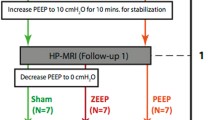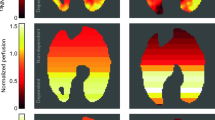Abstract
An animal model of oxygen-induced pulmonary injury was used to assess the potential of contrastenhanced MRI to identify and quantify abnormal capillary permeability. Sprague-Dawley rats were exposed to 100% oxygen for 48 h (n=5) or 60 h (n=9). Axial spinecho MR images were acquired in intubated, anesthetized rats with ECG-gating (TR 400; TE 6) immediately or 7 days after the cessation of oxygen exposure. Polylysine-Gd-DTPA, a macromolecular paramagnetic blood-pool marker, was then given intravenously and the lungs were serially imaged for 42 to 47 min to monitor changes in signal intensity. Pulmonary enhancement was stable in rats exposed to 48 h of oxygen, and in rats exposed to 60 h of oxygen and given 7 days to recover. However, animals exposed to 100% oxygen for 60 h without a period of recovery showed a progressive increase in lung signal intensity for 15 min after polylysine-Gd-DTPA. Pleural effusions also showed progressively increasing signal, reflecting a capillary endothelial leak. A two compartment model describing the kinetics of polylysine-Gd-DTPA in the plasma and interstitial water of the lung was consistent with the dynamic MRI data and allowed estimation of the fractional leak rate (0.235 min−1) of the contrast agent from plasma to interstitial water. Given the assumption of our kinetic model, MRI following intravenous administration of polylysine-Gd-DTPA can be used to quantitate changes in capillary integrity induced by hyperoxia, including acute capillary leakiness and return to normal endothelial integrity with recovery from hyperoxic injury.
Similar content being viewed by others
References
Bryan CL, Jenkinson SG (1988) Oxygen toxicity. Clin Chest Med 9:141–152
Klein J (1990) Normobaric pulmonary oxygen toxicity. Anesth Analg 70:195–207
Fiascone JM, Rhodes TT, Grandgeorge SR, Knapp MA (1989) Bronchopulmonary dysplasia: a review for the pediatrician. Curr Probl Pediatr 19:169–227
Deneke SM, Fanburg BL (1980) Normobaric oxygen toxicity of the lung. N Engl J Med 303:76–86
Royston BD, Webster NR, Nunn J (1990) Time course of changes in lung permeability and edema in the rat exposed to 100% oxygen. J Appl Physiol 69:1532–1537
Frank L, Bucher JR, Roberts RJ (1978) Oxygen toxicity in neonatal and adult animals of various species. J Appl Physiol 45: 699–704
Berthezene Y, Vexler V, Jerome H, Sievers R, Moseley ME, Brasch RC (1991) Differentiation of capillary leak and hydrostatic pulmonary edema with a macromolecular MR imaging contrast agent. Radiology 181:773–777
Renkin EM (1959) Transport of potassium-42 from blood to tissue in isolated mammalian skeletal muscles. Am J Physiol 197: 1205–1210
Crone C (1963) The permeability of capillaries in various organs as determined by the use of the indicator diffusion method. Acta Physiol Scand 58:292–305
Berman M, Weiss MF (1978) SAAM manual. DHEW Publication No. (NIH) 78-170. National Institutes of Health
Berman M, Beltz WF, Greif PC, Chabay R, Boston RC (1983) CONSAN users guide, US Dept of Health and Human Services, Public Health Service, National Institutes of Health, Bethesda, Md
Wolfe CL, Moseley ME, Wikstrom MG et al (1989) Assessment of myocardial salvage after ischemia and reperfusion using magnetic resonance imaging and spectroscopy. Circulation 80:969–982
Schmiedl U, Sievers RE, Brasch RC et al (1989) Acute myocardial ischemia and reperfusion: MR imaging with albumin-Gd-DTPA. Radiology 170:351–356
Wikstrom MG, Moseley ME, White DL et al (1989) Contrast-enhanced MRI of tumors: comparison of Gd-DTPA and a macromolecular agent. Invest Radiol 24:609–615
Aicher KP, Dupon JW, White DL et al (1990) Contrast-enhanced magnetic resonance imaging of tumor-bearing mice treated with human recombinant tumor necrosis factor alpha. Cancer Res 50: 7376–7381
Davis WB, Rennard SI, Bitterman PB, Crystal RG (1983) Pulmonary oxygen toxicity. Early reversible changes in human alveolar structures induced by hyperoxia. N Engl J Med 309:878–883
Crapo JD, Barry BE, Foscue HA, Shelburne J (1990) Structural and biochemical changes in rat lungs occurring during exposures to lethal and adaptive dose of oxygen. Am Rev Respir Dis 122: 123–143
Katzenstein AL, Bloor CM, Leibow AA (1976) Diffuse alveolar damage. The role of oxygen, shock, and related factors Am J Pathol 85:210–228
Robinson FR, Thomas AA, Rendon L (1968) Analysis of pleural effusion from rats exposed to high concentrations of oxygen. Clin Chem 14:1066–1073
Bernaudin JF, Theven D, Pinchon MC, Brun-Pascaud M, Bellon B, Pocidalo JJ (1986) Protein transfer in hyperoxic induced pleural effusion in the rat. Exp Lung Res 10:23–28
McLaughlin RF, Tyler WS, Canada RO (1961) The subgross pulmonary anatomy in various mammals and man. JAMA 175:694–702
Brasch RC: Unpublished data
Evans ML, Graham MM, Mahler PA, Rasey JA (1986) Changes in vascular permeability following thorax irradiation in the rat. Radiat Res 107:262–271
Graham MM, Evans ML (1991) A simple dual tracer method for the measurement of transvascular flux of albumin into the lung. Microvasc Res 42:266–279
Author information
Authors and Affiliations
Additional information
This study was supported in part by CA 49786 from the National Cancer Institute. Y.B. was supported in part by Bourse de Recherche Scientifique et Technique du Traite de l'Atlantique Nord (O.T.A.N.)
Rights and permissions
About this article
Cite this article
Brasch, R.C., Berthezène, Y., Vexler, V. et al. Pulmonary oxygen toxicity: Demonstration of abnormal capillary permeability using contrast-enhanced MRI. Pediatr Radiol 23, 495–500 (1993). https://doi.org/10.1007/BF02012128
Received:
Accepted:
Issue Date:
DOI: https://doi.org/10.1007/BF02012128




